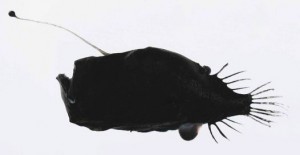Love at First Bite
In the deep waters of the ocean, with conditions so severe that life seems impossible, lives the Triplewart Seadevil, Cryptopsaras couesii, a species of Anglerfish.
 A 5 cm standard length Triplewart Seadevil
A 5 cm standard length Triplewart Seadevil
by Robin McPhee © NORFANZ Founding Parties
In a lightless environment with bitter cold temperatures and enormous water pressure, the Cryptopsaras couesii has cleverly adapted to cope with these inhospitable conditions. One renowned adaptation is its bioluminescent lure used to attract prey. The focus today, however, is its less known, yet ingeniously designed sure-win mating strategy, allowing it to find love in a ‘hopeless’ place.
The Cryptopsaras couesii shows extreme sexual dimorphism, where males are only one-tenth the size of females. Furthermore, due to their rudimentary anatomical system, males have short lifespans. However, they have an exceptional olfactory organ that allows them to sense pheromones released by females and in turn, find the love of their lives and their means of survival; Male and female Cryptopsaras couesii share a unique symbiotic relationship, often referred to as sexual parasitism.
Once the male locates the female, it is love at first bite. With his specially designed teeth, he bites into her belly, permanently fastening himself to her. Their circulatory systems combine, in which the female provides a lifetime supply of blood-transported nutrients to the attached male. Over time, the male loses its organs and eyes, atrophying into nothing but a bag of sperms ready for discharge for fertilization. The female allows up to six males to attach to her. I suppose in a dark, cold, lonely environment such as this, misery loves company indeed.
In this way, the Cryptopsaras couesii has truly taken the meaning of love and union to a whole new level. Evolutionary change could be the reason for this incredible adaptation, but some suggest that intelligence planned for this so that love can exist even in the deserts of the oceans.
To watch this fascinating union: (1:35 – 2:35)
References
Pietsch, T. W. (1976). Dimorphism, Parasitism and Sex: Reproductive Strategies among Deepsea Ceratioid. Copeia, Vol. 1976, No. 4 , 781-793.
Pietsch, T. W. (2005). Dimorphism, parasitism, and sex revisited: modes of reproduction. Ichthyological Research, 207–236.
Tanneberger, C. (n.d.). Retrieved from Parasitism in the deep-sea anglerfish: http://extrememarine.org.uk/deepparasites/all-the-different-parasites/parasite-b/
“World’s Weirdest: Weird Killer of the Deep” by NatGeoWild Youtube Channel, 4 Apr 2012
URL: http://www.youtube.com/watch?v=XUVerZsbYiw (accessed on 6 Apr 2013)
“A 5 cm standard length Triplewart Seadevil” by Robin McPhee © NORFANZ Founding Parties
URL: http://australianmuseum.net.au/Triplewart-Seadevil-Cryptopsaras-couesii-Gill-1883/ (accessed on 6 Apr 2013)